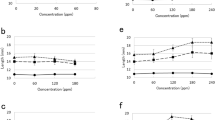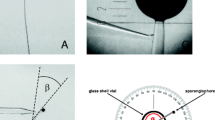Abstract
Phenylacetic acid (PAA) significantly stimulated the elongation of isolated Phaseolus vulgaris internodal segments and prevented the decline in acid invertase specific activity observed in segments incubated in the absence of growth substances. Unlike IAA, which stimulated both elongation and invertase activity over a very wide range of concentrations (<10-4 - 1 mol.m-3; optimum 10-2 mol.m-3), the response to PAA was restricted to a much narrower range of concentrations (3 × 10-2 - 1 mol.m-3; optimum ca. 1–2 × 10-1mol.m-3). At the optimum concentration of PAA, the stimulation of both responses was about 63–75% of that induced by the optimum concentration of IAA. The differences in the concentration range and magnitude of the responses to IAA and PAA were not due to differences in uptake of the two compounds. The stimulation of elongation by both compounds was prevented by 3.6 × 10-2mol.m-3 cycloheximide (CH), and acid invertase activites were greatly reduced compared with samples treated with growth substances alone. A saturating concentration of the specific auxin efflux carrier inhibitor N-1-naphthylphthalamic acid (NPA) slightly promoted the growth of control segments, probably by reducing the loss of residual endogenous auxin to the incubation medium. The elongation induced by PAA at its optimum concentration was considerably greater than the elongation induced by NPA, indicating that PAA did not cause growth by preventing the loss of endogenous auxin from the segments. Elongation responses to combinations of IAA and PAA suggested that the compounds were acting additively and that they were affecting growth by the same mechanism.
Similar content being viewed by others
References
Brummell DA and Hall JL (1980) The role of the epidermis in auxin-induced and fusicoccin-induced elongation of Pisum sativum stem segments. Planta 150: 371–379.
Johnson CF and Morris DA (1987) Regulation of auxin transport in the pea (Pisum sativum L.) by phenylacetic acid: Effects on the components of transmembrane transport of indol-3yl-acetic acid. Planta 172: 400–407.
Hestrin S, Feingold DS and Schram M (1955) Hexoside hydrolases. In: SpColowick and NOKaplan, eds. Methods in Enzymology, Volume 1, pp. 231–257. New York: Academic Press.
Lowry OH, Rosebrough NJ, Farr AL and Randall RJ (1951) Protein measurement with the Folin-phenol reagent. J Biol Chem 193: 265–275.
Milborrow BV, Purse JG and Wightman F (1975) On the auxin activity of phenylacetic acid. Ann Bot 39: 1143–1146.
Morris DA and Arthur ED (1984a) An association between acid invertase activity and cell growth during leaf expansion in Phaseolus vulgaris L. J Exp Bot 35: 1369–1379.
Morris DA and Arthur ED (1984b) Invertase and auxin-induced elongation in internodal segments of Phaseolus vulgaris. Phytochemistry 23: 2163–2167.
Morris DA and Arthur ED (1985) Invertase activity, carbohydrate metabolism and cell expansion in the stem of Phaseolus vulgaris L. J Exp Bot 36: 623–633.
Morris DA and Arthur ED (1986) Stimulation of acid invertase activity by indol-3yl-acetic acid in tissues undergoing cell expansion. Plant Growth Reg 4: 259–271.
Morris DA and Johnson CF (1987) Regulation of auxin transport in pea (Pisum sativum L.) by phenylacetic acid: Inhibition of polar auxin transport in intact plants and in stem segments. Planta 172: 408–416.
Schneider EA and Wightman F (1978) Auxins. In: DSLetham, PBGoodwin and TJVHiggins, eds. Phytohormones — A Comprehensive Treatise, Volume 1, pp. 29–105. Amsterdam Oxford New York: Elsevier/North-Holland Biomedical Press.
Schneider EA and Wightman F (1986) Auxins of non-flowering plants I. Occurrence of 3-indoleacetic acid and phenylacetic acid in vegetative and fertile fronds of the ostrich fern (Matteucia struthiopteris). Physiol Plant 68: 396–402.
Schneider EA, Kazakoff CW and Wightman F (1985) Gas chromatography-mass spectrometry evidence for several endogenous auxins in pea seedling organs. Planta 165: 232–241.
Suttle JC and Mansager ER (1986) The physiological significance of phenylacetic acid in abscising cotton cotyledons. Plant Physiol 81: 434–438.
Taylor DC and Wightman F (1987) Metabolism of D,L-chloro-phenylalanines by phenylalanine aminotransferase isozymes purified from bushbean shoots. Phytochemistry 26: 1279–1288.
Wheeler AW (1977) Auxin-like growth activity of phenylacetonitrile. ann Bot 41: 867–872.
Wightman F and Lighty DL (1982) Identification of phenylacetic acid as a natural auxin in the shoots of higher plants. Physiol Plant 55: 17–24.
Wightman F, Schneider EA and Thimann KV (1980) Hormonal factors controlling the initiation and development of lateral roots. II. Effects of exogenous growth factors on lateral root formation in pea roots. Physiol Plant 49: 304–314.
Author information
Authors and Affiliations
Rights and permissions
About this article
Cite this article
Small, D.K., Morris, D.A. Promotion of elongation and acid invertase activity in Phaseolus vulgaris L. internode segments by phenylacetic acid. Plant Growth Regul 9, 329–340 (1990). https://doi.org/10.1007/BF00024918
Received:
Accepted:
Issue Date:
DOI: https://doi.org/10.1007/BF00024918




